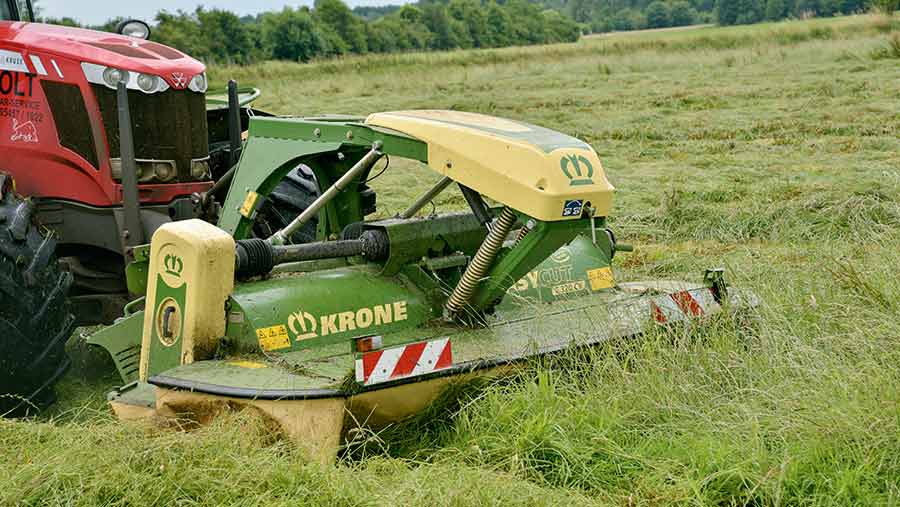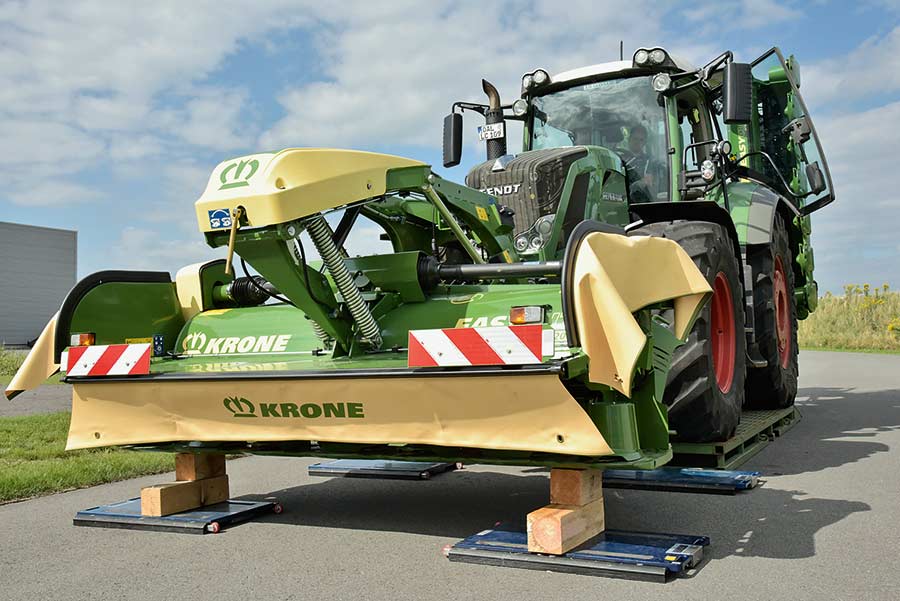Front mowers on test – is pushed or pulled best?
If you are shopping for a new front mower, aside from the brand, there’s one big decision to make – whether you want a push or a pull front suspension option.
What’s the difference? A pushed machine requires the top and bottom links to pivot freely for the mower to follow the ground contours, whereas a pulled machine uses the suspending arms to hug the ground and avoid obstacles.
To assess the qualities of each system, our colleagues at Top Agrar compared Krone’s EasyCut F 320 CV in both designs at a test farm in western Germany.
It’s worth noting here that the pulled version carries a £1,500 premium, but it is also possible to convert pushed to pulled if you change your mind post-purchase.
See also: Tips for buying a set of second-hand triple mowers

Design and tractor attachment
The pushed version
The mower mounts directly on the tractor’s link arms without an A-frame, so it’s essential that the lower links pivot freely.
The shorter the link arms, the closer the machine is mounted to the axle, which is good for contouring. In working position, the lower links should also point slightly upwards in the direction of travel – if they point downwards, they will increase the mower’s ground pressure.
The simple design means the pushed machine has no pivot points, no extra suspension arms, nor any other elements that would be prone to wear. It also does without a hydraulic coupler and is raised with the front linkage.
In the test we were able to lift it to a maximum height of 49cm. Running 2.6m ahead of the front axle (measured from the disc blade to the centre of our Fendt 828’s front axle), the pushed mower mounted 25cm closer to the tractor than the pulled version.
This benefits weight distribution on the front axle, which was 2.92t.
The pulled version
The centre-of-gravity suspension system breaks the connection between the mower and the front linkage.
The three-point connection consists of a forward mounted point of draft and two rods further back.
An integral ram uses one single-acting spool to move the mower up and down irrespective of the position of the lower links, so the links themselves are rigid and do not pivot.

The ram lifts the mower up to 45cm, but, if necessary, it is also possible to raise the machine higher than that with the tractor’s linkage.
The pulled mower sticks out 2.85m, which is 25cm longer than the pushed version and places an extra 500kg on the front axle (3.36t front axle load).
The suspension concept
We measured the pressure with the mower set in three different positions: at 0cm (on the same plane as the tractor wheels), at +15cm, which simulated a hump, and at -15cm, simulating a dip.
The target ground pressure value at 0cm was 80kg/m, which translates into 250kg across the entire machine.
The pushed version
The pushed mower uses coil springs and chains (or turnbuckles) to account for ground undulations, but these also bear some weight of the link arms.
The layout of the pushed model provides a bit more room around the suspension springs because it does without the A-frame and because the two tension springs have different dimensions, so that one fits into the other. The drawback of this set-up is the limited springing action.
The chains or turnbuckles are attached to the tractor and adjusting their length alters the resistance of the springs.
Ideally, the two chains should be set to different lengths to compensate for the nearside gearbox that drives the discs, because it’s a bit heavier than the offside gearbox that drives the conditioner.
Transferring the pushed mower to another tractor is a big job, because no two tractor linkages are the same and the springs need adjusting to suit each individual tractor.
Ideally, the springs should be positioned at the most shallow angle possible for a consistent ground pressure.
With pressure set to about 250kg in position 0, the actual force exerted by the machine dropped nearly to zero (0kg to 25kg) when we simulated travel through a dip (-15cm).
Vice versa, it increased significantly when we simulated a hump (+15cm), reaching 415kg at the recommended angle and sometimes much more than that.
With the springs set to a position that produced the best results, the pressure difference between the hump and dip position was about 400kg, which is probably caused by the relatively short suspension travel of the springs.
The pulled version
The pulled version has two long tension springs that suspend the mower in a three-point suspension system. It’s important to maintain the correct distance between the system’s nose and the mower itself, which is dictated by the height of the link arm (an arrow mark helps operators to find the correct position).
The tension springs are adjusted to current conditions by operating a spindle on the machine’s front.
We found the system worked very well – with the ground pressure set to 250kg at 0cm, we measured 85kg at -15cm and about 385kg at +15cm.
That meant the difference between the highest and lowest measuring point was 300kg, which betters the result of the pushed mower by more than 100kg.
Contouring
The pushed version
The cutting height is set by simply adjusting the top link.
However, sideways travel is limited by the lower links. Side-to-side movement was measured by parking the tractor on a ramp and pressing down one end of the mower until stop, which totalled 39cm with our Fendt 828.
The mower mounts 25cm closer to the axle, which improves ground contour following in gently undulating fields. The close attachment to the tractor is also helpful for tight headland turns.
In our rough, wet field the pushed machine seemed to perform more smoothly than the pulled version, because most of the machine’s movement is compensated by the lower links.
Raising the linkage to reduce the pressure in very wet patches automatically alters the cutting height, but adjusting the suspension springs is a big job and is unlikely to be done very often.
The pulled version
This machine pivots irrespective of the tractor links and through a larger 40cm range.
In our tests, it seemed to be more “active” than the pushed version, moving more frequently up and down and to the sides. Nevertheless it didn’t offer many advantages in maintaining a consistent cutting height in our extremely undulating field.
However, this design allowed our driver to respond rapidly to varying conditions. The ground pressure is reduced by raising the lower links, which does not necessarily change the cutting height that is maintained throughout a large range.
If that isn’t enough, you can quickly change the spring tension on the crank.
Verdict
- The pushed mower places 500kg less strain on the axle and is £1,500 cheaper
- The pushed mower mounts 25cm closer to the axle, so performs better on slopes and through curves
- The suspension system on the pulled mower is better balanced and there’s no need to adjust the springs to suit individual tractor linkages
- The pulled machine allows operators to respond more flexibly to changing conditions by raising the suspension unit
Push v pull: the results |
||
|
Krone EasyCut F 320 CV |
Push |
Pull |
|
Front axle weight |
2.92t |
3.36t |
|
Distance from front axle |
2.6m |
2.85m |
|
0 |
250kg |
250kg |
|
-15cm (dip) |
85kg |
25kg |
|
+15cm (hump) |
385kg |
415kg |

